PostgreSQL+pgpool-II复制方案
title: PostgreSQL+pgpool-II复制方案
tags: PostgreSQL,pgpool-II
author: Chinge Yang
date: 2017-02-15
PostgreSQL+pgpool-II复制方案
@(学习)[PostgreSQL, pgpool-II, 高可用]
1. Pgpool-II介绍
pgpool-II是PostgreSQL服务器之间一种有效的中间件和PostgreSQL数据库客户端。它提供了以下功能。
连接池
pgpool-II保存到PostgreSQL服务器的连接,当一个相同新连接(如用户名、数据库、协议版本)进来时,重用他们。它减少了连接开销,提高了系统的整体吞吐量。
复制
pgpool-II可以管理多个PostgreSQL服务器。使用复制功能可以使2个或更多的物理磁盘上创建一个实时备份,这样服务不会因服务器的磁盘故障而中断。
负载平衡
如果数据库是复制的,在任何服务器上执行一个SELECT查询会返回相同的结果。pgpool-II复制特性的优势在于减少每个PostgreSQL服务器上的负载,因为它可以使用分布在多个服务器之间进行SELECT查询,从而提高系统的整体吞吐量。最好是查询和PostgreSQL服务器数量成一定比例,多用户同时执行多查询达到负载均衡最好的效果。
限制连接数
PostgreSQL的最大并发连接数有一定限制的,当超过限制的连接数后,连接会被拒绝。然而,设置增加最大连接数又会增加资源消耗,影响系统性能。pgpool-II也有最大连接数限制,但超过的连接进来时是进行立即排队,而不是返回一个错误。
pgpool-II交互PostgreSQL的后端和前端协议时,起着继电器的作用。因此,数据库应用程序(前端)认为pgpool-II是真实的PostgreSQL服务器,服务器(后端)认为pgpool-II是它的客户端之一。因为pgpool-II在服务器和客户端是透明的,所以pgpool-II可以使用现有的数据库应用程序而做到几乎不修改它们。
环境:
CentOS6.8
PostgreSQL9.5
pgpool-II-pg95-3.6.1
2. pgpool-II安装
2.1 安装pgpool-II yum源,并安装pgpool-II
从官网找到相关yum源rpm包,使用rpm安装后,并使用yum安装pgpool-II
rpm -ivh http://www.pgpool.net/yum/rpms/3.6/redhat/rhel-6-x86_64/pgpool-II-release-3.6-1.noarch.rpm
yum -y install pgpool-II-pg95
yum -y install pgpool-II-pg95-debuginfo
yum -y install pgpool-II-pg95-devel
yum -y install pgpool-II-pg95-extensions
chkconfig pgpool on # 添加开机启动
service start/stop pgpool # 服务启/停
2.2 添加Pgpool-II运行用户
添加Pgpool-II运行用户,并给相关目录的读写权限
[root@im110 pgpool-II]# useradd pgpool
[root@im110 pgpool-II]# passwd pgpool
Changing password for user pgpool.
New password:
Retype new password:
passwd: all authentication tokens updated successfully.
[root@im110 pgpool-II]# chown -R pgpool.pgpool /etc/pgpool-II
[root@im110 pgpool-II]# mkdir -p /var/run/pgpool/
[root@im110 pgpool-II]# chown pgpool.pgpool /var/run/pgpool/
修改启动脚本的pgpool运行用户:
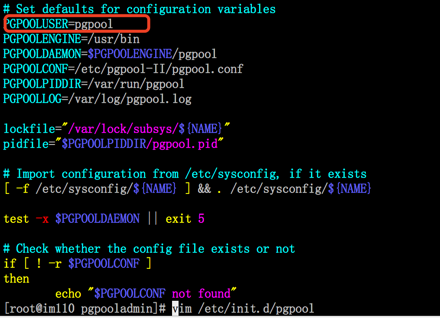
2.3 设置pcp.conf
cp /etc/pcp.conf.sample /etc/pcp.conf
内容格式为如下,一行一个,#号为注释标识
username:[md5 encrypted password]
[md5 encrypted password] 可以使用如下命令生成
$ pg_md5 pgpool
ba777e4c2f15c11ea8ac3be7e0440aa0
使用pg_md5 -p会隐藏输入的密码
$ pg_md5 -p
password: your_password
配置文件pcp.conf必须允许pgpool执行用户可读。
2.4 设置Pgpool-II配置文件
pgpool.conf是Pgpool-II的主配置文件。启动Pgpool-II时可以使用 -f 参数指定 pgpool.conf路径, 默认是使用/etc/pgpool.conf.
Pgpool-II每个模式对应的配置文件模板

复制一份作为你的配置文件:
# cd /etc
# cp pgpool.conf.sample-replication pgpool.conf
2.5 配置backend信息
在pgpool.conf中加入如下格式的配置,其中0为backend主机号,不能重复。
backend_socket_dir = '/tmp'
backend_hostname0 = '10.1.0.110'
backend_port0 = 5432
backend_weight0 = 1
backend_data_directory0 = '/var/lib/pgsql/9.5/data/'
backend_flag0 = 'ALLOW_TO_FAILOVER'
2.6 修改认证方式
2.6.1. 修改pgpool-II的认证方式为md5
vim /etc/pgpool-II/pool_hba.conf
# TYPE DATABASE USER CIDR-ADDRESS METHOD
host all all 10.1.0.0/24 md5
# "local" is for Unix domain socket connections only
local all all md5
# IPv4 local connections:
host all all 127.0.0.1/32 md5
host all all ::1/128 md5
2.6.2. 修改PostgreSQL的认证方式为md5
vim pg_hba.conf
# TYPE DATABASE USER ADDRESS METHOD
# "local" is for Unix domain socket connections only
# IPv4 local connections:
host all all 127.0.0.1/32 trust
host all all 10.1.0.0/24 md5
# IPv6 local connections:
host all all ::1/128 trust
# Allow replication connections from localhost, by a user with the
# replication privilege.
local all postgres md5
#local replication postgres peer
#host replication postgres 127.0.0.1/32 ident
#host replication postgres ::1/128 ident
[root@im110 pgpool-II]#
2.7 测试pgpool-II同步
这里作简单测试,在pgpool-II入口创建数据库,看各节点是否自动创建,删除后,看各节点是否自动删除。
[root@im109 ~]# psql -U postgres -h 10.1.0.115 -p 9999
Password for user postgres:
psql (9.5.6)
Type "help" for help.
postgres=# show pool_nodes;
node_id | hostname | port | status | lb_weight | role | select_cnt | load_balance_node | replication_delay
---------+------------+-------+--------+-----------+--------+------------+-------------------+-------------------
0 | 10.1.0.110 | 54321 | up | 0.500000 | master | 0 | true | 0
1 | 10.1.0.109 | 54321 | up | 0.500000 | slave | 0 | false | 0
(2 rows)
postgres=#
postgres=# \l
List of databases
Name | Owner | Encoding | Collate | Ctype | Access privileges
-----------+----------+----------+-------------+-------------+-----------------------
postgres | postgres | UTF8 | en_US.UTF-8 | en_US.UTF-8 |
template0 | postgres | UTF8 | en_US.UTF-8 | en_US.UTF-8 | =c/postgres +
| | | | | postgres=CTc/postgres
template1 | postgres | UTF8 | en_US.UTF-8 | en_US.UTF-8 | =c/postgres +
| | | | | postgres=CTc/postgres
wiseucmsg | postgres | UTF8 | en_US.UTF-8 | en_US.UTF-8 |
(4 rows)
postgres=# create database test01;
CREATE DATABASE
postgres=# \q
[root@im109 ~]# psql -U postgres -h 10.1.0.110 -p 54321
Password for user postgres:
psql (9.5.6)
Type "help" for help.
postgres=# \l
List of databases
Name | Owner | Encoding | Collate | Ctype | Access privileges
-----------+----------+----------+-------------+-------------+-----------------------
postgres | postgres | UTF8 | en_US.UTF-8 | en_US.UTF-8 |
template0 | postgres | UTF8 | en_US.UTF-8 | en_US.UTF-8 | =c/postgres +
| | | | | postgres=CTc/postgres
template1 | postgres | UTF8 | en_US.UTF-8 | en_US.UTF-8 | =c/postgres +
| | | | | postgres=CTc/postgres
test01 | postgres | UTF8 | en_US.UTF-8 | en_US.UTF-8 |
wiseucmsg | postgres | UTF8 | en_US.UTF-8 | en_US.UTF-8 |
(5 rows)
postgres=# \q
[root@im109 ~]# psql -U postgres -h 10.1.0.109 -p 54321
Password for user postgres:
psql (9.5.6)
Type "help" for help.
postgres=# \l
List of databases
Name | Owner | Encoding | Collate | Ctype | Access privileges
-----------+----------+----------+-------------+-------------+-----------------------
postgres | postgres | UTF8 | en_US.UTF-8 | en_US.UTF-8 |
template0 | postgres | UTF8 | en_US.UTF-8 | en_US.UTF-8 | =c/postgres +
| | | | | postgres=CTc/postgres
template1 | postgres | UTF8 | en_US.UTF-8 | en_US.UTF-8 | =c/postgres +
| | | | | postgres=CTc/postgres
test01 | postgres | UTF8 | en_US.UTF-8 | en_US.UTF-8 |
wiseucmsg | postgres | UTF8 | en_US.UTF-8 | en_US.UTF-8 |
(5 rows)
postgres=# \q
[root@im109 ~]# psql -U postgres -h 10.1.0.115 -p 9999
Password for user postgres:
psql (9.5.6)
Type "help" for help.
postgres=# \l
List of databases
Name | Owner | Encoding | Collate | Ctype | Access privileges
-----------+----------+----------+-------------+-------------+-----------------------
postgres | postgres | UTF8 | en_US.UTF-8 | en_US.UTF-8 |
template0 | postgres | UTF8 | en_US.UTF-8 | en_US.UTF-8 | =c/postgres +
| | | | | postgres=CTc/postgres
template1 | postgres | UTF8 | en_US.UTF-8 | en_US.UTF-8 | =c/postgres +
| | | | | postgres=CTc/postgres
test01 | postgres | UTF8 | en_US.UTF-8 | en_US.UTF-8 |
wiseucmsg | postgres | UTF8 | en_US.UTF-8 | en_US.UTF-8 |
(5 rows)
postgres=# drop database test01;
DROP DATABASE
postgres=# \l
List of databases
Name | Owner | Encoding | Collate | Ctype | Access privileges
-----------+----------+----------+-------------+-------------+-----------------------
postgres | postgres | UTF8 | en_US.UTF-8 | en_US.UTF-8 |
template0 | postgres | UTF8 | en_US.UTF-8 | en_US.UTF-8 | =c/postgres +
| | | | | postgres=CTc/postgres
template1 | postgres | UTF8 | en_US.UTF-8 | en_US.UTF-8 | =c/postgres +
| | | | | postgres=CTc/postgres
wiseucmsg | postgres | UTF8 | en_US.UTF-8 | en_US.UTF-8 |
(4 rows)
postgres=# \q
[root@im109 ~]# psql -U postgres -h 10.1.0.110 -p 54321
Password for user postgres:
psql (9.5.6)
Type "help" for help.
postgres=# \l
List of databases
Name | Owner | Encoding | Collate | Ctype | Access privileges
-----------+----------+----------+-------------+-------------+-----------------------
postgres | postgres | UTF8 | en_US.UTF-8 | en_US.UTF-8 |
template0 | postgres | UTF8 | en_US.UTF-8 | en_US.UTF-8 | =c/postgres +
| | | | | postgres=CTc/postgres
template1 | postgres | UTF8 | en_US.UTF-8 | en_US.UTF-8 | =c/postgres +
| | | | | postgres=CTc/postgres
wiseucmsg | postgres | UTF8 | en_US.UTF-8 | en_US.UTF-8 |
(4 rows)
postgres=# \q
[root@im109 ~]# psql -U postgres -h 10.1.0.109 -p 54321
Password for user postgres:
psql (9.5.6)
Type "help" for help.
postgres=# \l
List of databases
Name | Owner | Encoding | Collate | Ctype | Access privileges
-----------+----------+----------+-------------+-------------+-----------------------
postgres | postgres | UTF8 | en_US.UTF-8 | en_US.UTF-8 |
template0 | postgres | UTF8 | en_US.UTF-8 | en_US.UTF-8 | =c/postgres +
| | | | | postgres=CTc/postgres
template1 | postgres | UTF8 | en_US.UTF-8 | en_US.UTF-8 | =c/postgres +
| | | | | postgres=CTc/postgres
wiseucmsg | postgres | UTF8 | en_US.UTF-8 | en_US.UTF-8 |
(4 rows)
postgres=# \q
[root@im109 ~]#
测试成功,说明从pgpool-II入口操作,各节点会同步数据。
3. 安装pgpoolAdmin(不推荐)
虽然官网提供此工具,用于页面管理pgpool,但是我觉得不安全,且可能bug较多。以下文中会有一些bug列出来。
安装方法:
3.1 解压pgpoolAdmin至web目录,使用户能访问其php
wget http://www.pgpool.net/download.php?f=pgpoolAdmin-3.5.3.tar.gz -O pgpoolAdmin-3.5.3.tar.gz
cd /var/www
tar -zxvf pgpoolAdmin-3.5.3.tar.gz
ln -s pgpoolAdmin-3.5.3 pgpooladmin
mkdir templates_c
chmod 777 templates_c
chown www conf/pgmgt.conf.php
chmod 644 conf/pgmgt.conf.php
3.2 php-fpm运行用户和pgpool用户统一
pgpoolAdmin使用pcp命令控制pgpool启停,因此需要统一php和pgpool运行用户,以便pgpoolAdmin从页面控制pgpool启停。可参考上文中2.2步骤操作。
3.3 根据向导完成安装
访问安装页面,完成检测,完成安装。
http://yourweb/pgpooladmin/install/

-
从上图看到,3.5下面的勾处未有文字提示,我此处为通过。因为我装了php-psql扩展。从源码中也可以看出,是检测pgsql扩展。

-
.pcppass文件格式如下(pgpool3.5以下用到):
它的作用是用于指定连接postgresql的连接串,包括主机、端口、用户、密码。
host:port:user:password
3.4 一些细节说明
完全设置好的完整功能如下:

1). 显示pgpoolAdmin运行机器的hostname
若php报warning,可在hosts中添加IP对应主机名
[root@im110 pgpoolAdmin-3.5.3]# vim /etc/hosts
10.1.0.110 im110
2). 此处为pgpoolAdmin的登录用户,superuser: yes表示在pgpool数据库中,用户为管理员用户。此数据库可以pgpool下,也可分离到其它postgresql中。若此处非yes,则节点相关操作为不可操作的灰色。
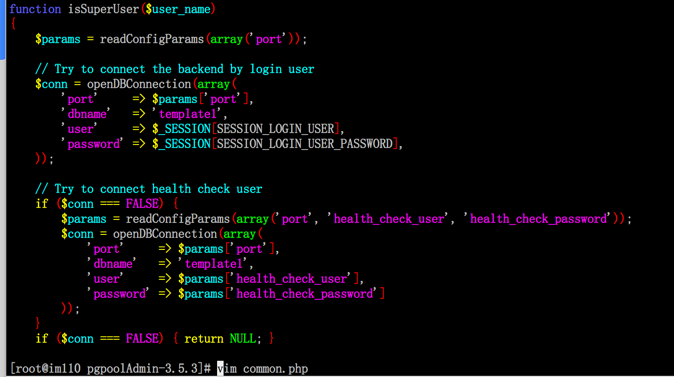
3). 页面中显示节点是否连接,是在pgpool中show pool_nodes命令下的节点status.
[root@im109 ~]# psql -U postgres -h 10.1.0.115 -p 9999
Password for user postgres:
psql (9.5.6)
Type "help" for help.
postgres=# show pool_nodes;
node_id | hostname | port | status | lb_weight | role | select_cnt | load_balance_node | replication_delay
---------+------------+-------+--------+-----------+--------+------------+-------------------+-------------------
0 | 10.1.0.110 | 54321 | up | 0.500000 | master | 0 | true | 0
1 | 10.1.0.109 | 54321 | up | 0.500000 | slave | 0 | false | 0
(2 rows)
其它命令参考官方文档:
http://www.pgpool.net/docs/latest/en/html/reference.html
4). pgpool.conf 设置中的健康检查,检查postgressql是否启动
此处是通过连接各节点是否成功来判断的,因此需要在各节点创建用于连接的角色。
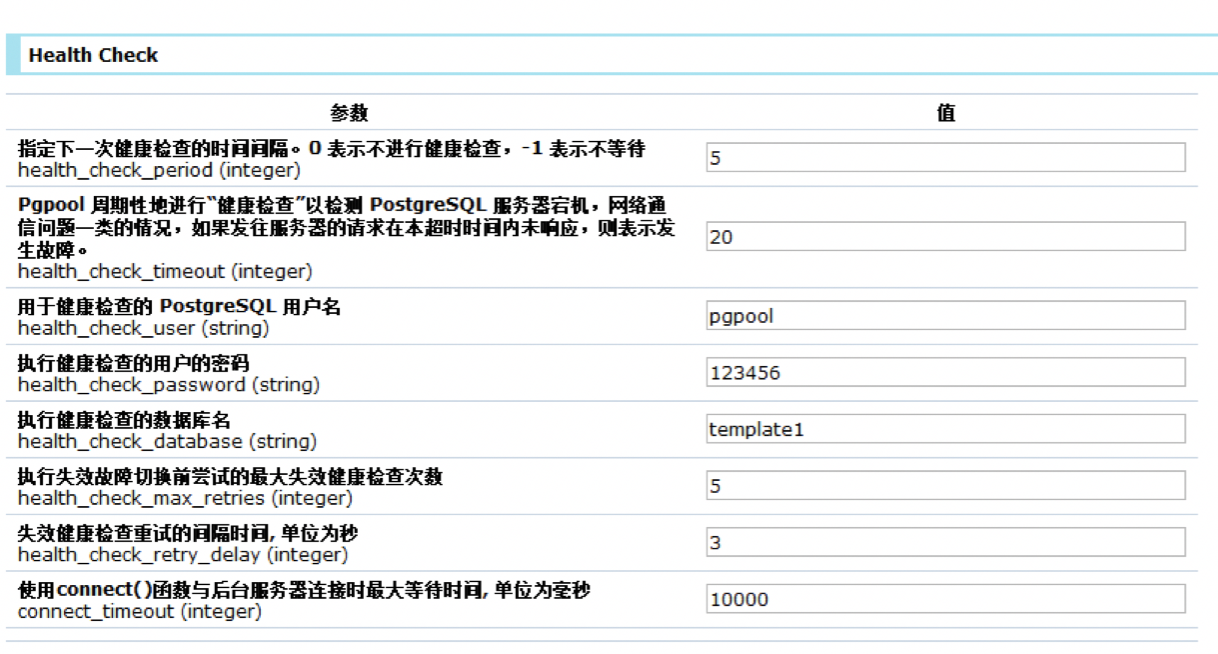
[root@im110 pgpool-II]# psql -U pgpool -p 54321 -h 10.1.0.110 template1
Password for user pgpool:
psql (9.5.6)
Type "help" for help.
template1=>
3.5 php.ini的disable_functions设置
源代码中php调用的exec执行pcp相关命令,
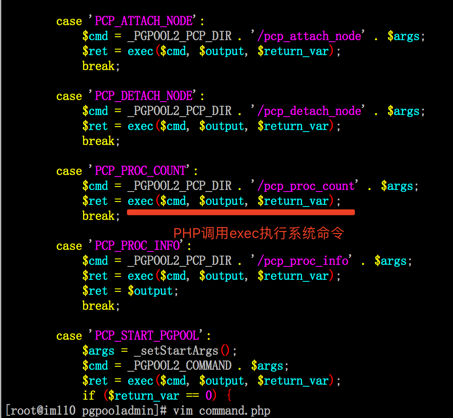
因此需要将php.ini配置文件中的disable_functions中的exec去掉,以允许php使用该函数。

3.6 pgpoolAdmin中pcp_stop_pgpool参数
在pgpool-II3.6中,pcp_stop_pgpool用法如下:
root@im110 pgpooladmin]# pcp_stop_pgpool --help
pcp_stop_pgpool - terminate pgpool-II
Usage:
pcp_stop_pgpool [OPTION...]
Options:
-U, --username=NAME username for PCP authentication
-h, --host=HOSTNAME pgpool-II host
-p, --port=PORT PCP port number
-w, --no-password never prompt for password
-W, --password force password prompt (should happen automatically)
-m, --mode=MODE MODE can be "smart", "fast", or "immediate"
-d, --debug enable debug message (optional)
-v, --verbose output verbose messages
-?, --help print this help
pgpoolAdmin中需要做相应修改。
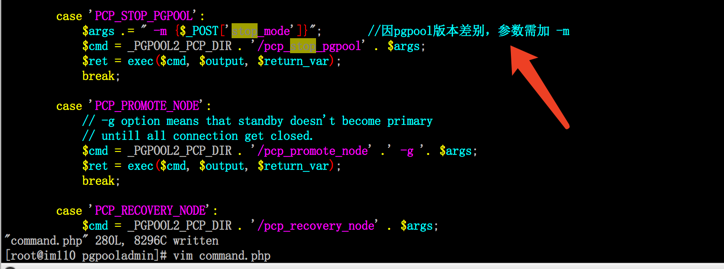
4. 总结
- 此PostgreSQL高可用方案搭建简单方便,且可以在不影响原来环境的基础上搭建;
- 生产环境中的pgpoool-II是怎样的我不好评判。网上此博客写的不错,可以看看,PG的两种集群技术:Pgpool-II与Postgres-XL


